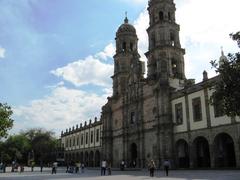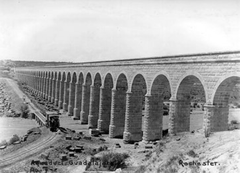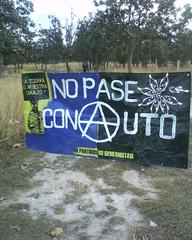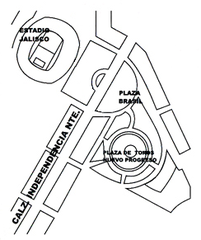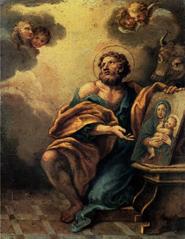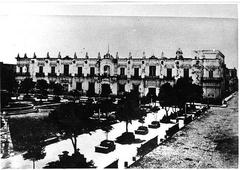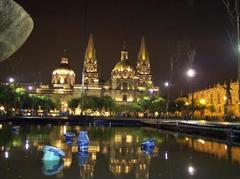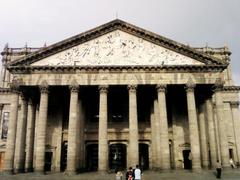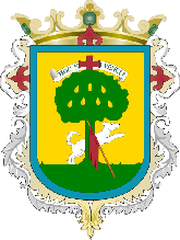
Centro Guadalajara Visiting Guide: Tickets, Hours, and Top Attractions
Date: 03/07/2025
Introduction to Centro Guadalajara and Its Historical Significance
At the heart of Mexico’s second-largest city, Guadalajara’s Centro Histórico is a vibrant tapestry of history, culture, and architectural marvels. This district is a living museum, where indigenous heritage meets Spanish colonial grandeur, and the pulse of modern Mexican life animates centuries-old plazas. From the neo-Gothic spires of the Guadalajara Cathedral to the UNESCO-listed Hospicio Cabañas, Centro Histórico is the gateway to understanding both the city and the nation’s identity. This guide provides essential information on visiting hours, ticketing, accessibility, and must-see landmarks, alongside practical tips and cultural insights for a memorable journey into the soul of Guadalajara. For additional travel resources and in-depth cultural guides, see PlanetWare, The Go Guy, and Wide World Trips.
Contents
- Introduction
- Indigenous Roots and Spanish Foundations
- Colonial Growth and Urban Planning
- Independence, Revolution, and Modernization
- Cultural Significance and Living Traditions
- Architectural and Artistic Heritage
- Visitor Information: Hours, Tickets, and Accessibility
- Practical Tips for Visitors
- Frequently Asked Questions (FAQs)
- Visual and Interactive Resources
- Further Exploration
- Conclusion
- Sources
Indigenous Roots and Spanish Foundations
Before Spanish conquest, the region of Guadalajara was home to thriving indigenous communities such as the Caxcanes and Tecuexes, whose legacy is visible in local traditions and nearby archaeological sites like Guachimontones. Founded in 1542 after a series of relocations due to indigenous resistance, Guadalajara was strategically positioned for fertile lands and trade routes. Its name comes from the Spanish city of Guadalajara in Castilla-La Mancha, reflecting colonial ambitions (PlanetWare).
Colonial Growth and Urban Planning
Guadalajara’s Centro Histórico flourished as the region’s religious and administrative core during the colonial era. The city’s urban plan, with four main plazas arranged around the central cathedral, exemplifies Spanish colonial design, emphasizing the importance of the Catholic Church and efficient governance. Monumental buildings such as the Guadalajara Cathedral, Government Palace, and ornate Baroque churches like Templo de Santa Mónica and Templo de San Agustín highlight the city’s architectural heritage (The Go Guy).
Independence, Revolution, and Modernization
Centro Histórico was pivotal in Mexico’s independence movement—Miguel Hidalgo issued the abolition of slavery from the Government Palace in 1810. The district witnessed key events throughout the independence and revolutionary periods, cementing its status as a cradle of national identity. The 19th and early 20th centuries brought modernization: railways, public lighting, and civic institutions. The Hospicio Cabañas, with its neoclassical design and José Clemente Orozco’s murals, is now a UNESCO World Heritage Site (PlanetWare).
Cultural Significance and Living Traditions
Guadalajara Centro is the birthplace of mariachi music and the folk dance Jarabe Tapatío, both celebrated in public performances and festivals. The region’s association with tequila, charrería (Mexico’s national sport), and local cuisine cements its reputation as the heart of Mexican identity. The city’s cultural legacy endures in its museums, lively markets like Mercado San Juan de Dios, and annual events such as the International Film Festival and Book Fair (Wide World Trips).
Architectural and Artistic Heritage
Centro’s streets showcase a blend of colonial, neoclassical, art deco, and modernist architecture. Highlights include the Instituto Cultural Cabañas—home to Orozco’s murals, the neoclassical Teatro Degollado, and the ornate Government Palace. These landmarks, alongside hidden courtyards and vibrant street art, invite exploration and photogenic discoveries (PlanetWare).
Visitor Information: Hours, Tickets, and Accessibility
Major Attractions and Details
-
Guadalajara Cathedral
- Hours: Daily 8:00 AM – 8:00 PM
- Admission: Free; guided tours approx. 100 MXN
- Accessibility: Wheelchair accessible
-
Museo Regional de Guadalajara
- Hours: Tue–Sun 10:00 AM – 6:00 PM
- Tickets: 70 MXN; free for children under 12/residents
- Accessibility: Wheelchair access available
-
Instituto Cultural Cabañas (Hospicio Cabañas)
- Hours: Tue–Sun 10:00 AM – 6:00 PM
- Tickets: 70–80 MXN; discounts for students/seniors
- Accessibility: Fully accessible; audio guides available
-
Government Palace (Palacio de Gobierno)
- Hours: Mon–Fri 9:00 AM – 5:00 PM
- Admission: Free
- Accessibility: Limited due to historic structure
-
Teatro Degollado
- Hours: Mon–Fri 9:00 AM – 3:00 PM (tours)
- Tickets: Tours approx. 50 MXN
- Accessibility: Wheelchair access
-
Mercado San Juan de Dios (Mercado Libertad)
- Hours: Daily 8:00 AM – 8:00 PM
- Accessibility: Mostly accessible, some narrow aisles
-
Rotonda de los Jaliscienses Ilustres, Plaza de Armas, Plaza de la Liberación, Templo Expiatorio, and other plazas
- Hours: Open public spaces
- Accessibility: Generally accessible
Ticketing and Tours
Combined tickets and guided tours are available through local operators and visitor centers, generally ranging from 200–400 MXN for half-day tours. Booking in advance is recommended during high season.
Accessibility
Most major sites have made efforts for accessibility, though some historic buildings have limitations. It is advisable for visitors with special needs to verify access in advance.
Practical Tips for Visitors
- Best Time to Visit: October–December for mild weather (78–82°F) and cultural events. Book early during festival seasons (Travellers Worldwide).
- Getting Around: Centro Histórico is walkable; Mi Bici rentals, taxis, and Uber are available (Playas y Plazas).
- Museum Hours: Many museums close Mondays—plan accordingly.
- Safety: Centro is generally safe; standard precautions advised, especially at night.
- Local Etiquette: Dress modestly in religious sites. Tipping 10–15% is customary.
Frequently Asked Questions (FAQs)
Q: What are the visiting hours of Guadalajara Cathedral?
A: Daily, 8:00 AM – 8:00 PM; free entry.
Q: How can I get tickets for museums?
A: Purchase at entrances or online via official websites.
Q: Is Centro Histórico safe at night?
A: Generally safe, but remain in well-lit areas and avoid isolated streets after dark.
Q: Are attractions wheelchair accessible?
A: Most major sites are, but check specifics in advance.
Q: Can I find guided tours in English?
A: Yes, city tourism offices and local operators offer English-language tours.
Visual and Interactive Resources
Explore interactive maps and virtual tours via official tourism websites. High-quality images and immersive content are available for major sites such as Guadalajara Cathedral and Instituto Cultural Cabañas.
Further Exploration
- Official Guadalajara Tourism Website
- Audiala App - Travel Smarter
- Centro Guadalajara historical sites
- Mariachi culture in Guadalajara
- Local Guided Tours
Conclusion
Guadalajara’s Centro Histórico is a vibrant crossroads of Mexico’s past and present, offering a captivating blend of architecture, tradition, and contemporary life. From monumental cathedrals and mural-filled palaces to bustling plazas and markets, Centro is both a repository of heritage and a living stage for modern Mexican culture. With accessible hours, affordable entry, and a welcoming atmosphere, it is a must-visit for travelers seeking the heart of Mexico. For real-time updates, guided tours, and insider tips, download the Audiala app and consult official tourism resources.
Sources
- Guadalajara Centro Histórico: Visiting Hours, Tickets, and Must-See Historical Sites, 2025, PlanetWare
- Top Must-See Attractions and Visiting Information for Guadalajara’s Centro Historic District, 2025, The Go Guy
- Visiting the Guadalajara Cathedral: History, Tips, and Local Customs, 2025, Audiala
- Exploring Guadalajara Cathedral: History, Visiting Hours, and Insider Tips, 2025, Audiala
- Guadalajara Neighborhoods, Mexican Cultural Festivals, Travel Tips for Jalisco, 2025, Travellers Worldwide
- Additional Context and Visitor Advice, 2025, Wide World Trips




